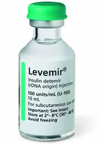I have recently switched one of my canine diabetic patients from NPH insulin to detemir. This is the first time I have used this insulin and I am looking for some help.
have recently switched one of my canine diabetic patients from NPH insulin to detemir. This is the first time I have used this insulin and I am looking for some help.
Rex is a 10-yr-old, male Schnauzer mix. We started him on 3 units of detemir twice daily and he is currently on 3.5 units twice daily.
We admitted Rex for a glucose curve today. His results were as follows:
8:00 am- 482 mg/dl (fasted and no insulin since 8 pm dose)
8:15 am- 3.5 units of detemir given and dog fed
9:15 am - 445 mg/dl
10:20 am- 301 mg/dl
12:30 pm- 147 mg/dl
1:25 pm- 97 mg/dl
2:30 pm- 80 mg/dl
3:30 pm- 72 mg/dl
4:40 pm- 82 mg/dl
5:10 pm- 108 mg/dl
I like the low glucose values in the middle of the day but am concerned about the severe morning hyperglycemia.
Any recommendations? Thank you for any help.
My Response:
How much does this dog weigh? The dose of detemir (Levemir insulin) we start at is generally around 0.1 mg/kg twice daily, so 7 U per day seems rather high (unless it's a big Schnauzer)
That all said, this curve doesn't look so bad. Like you, I'm not bothered by the afternoon glucoses. They still are normal and not low. Are the owners feeding the same food morning and night? Did the dog eat normally on the day of the glucose curve when hospitalized? If not, that could explain why the insulin worked so well that day; could it be that at home, the glucoses remain higher?
It seems unlikely that the blood sugar would go from 108 mg/dl at 5:10 PM to levels in the 400s 3 hours later when it's time for the shot again. Are the owners giving the insulin and then waiting before feeding?
If the dog is eating well, I like to give the insulin about 30 minutes before eating to ensure some insulin has been absorbed before feeding. We could consider that in this patient if not already being done.
Finally, is this dog feeling well? How if the thirst, appetite and attitude? We must always remember to look at the dog and talk to the owner. We can never just depend on blood glucose curves to make insulin dose adjustments,
Follow-up Information and Additional Questions:
Rex weighs 39 pounds (17.7 kg). The owners report that he is feeling great at home, has gained a little weight recently (1 pound over last 2 months). He is indeed feeling better, playing, and acting normal.
He didn't eat well while here for the curve so I would assume those middle-of-the-day glucose values would be higher at home. I can question the owners better about the timing of the feeding at home. I didn’t realize that could even be a factor!
Do you have owners feed the animal at home before coming in for the curve? Would the next step be to redo the glucose curve on a day when he has eaten that morning?
Would increasing the dose up to 4 units BID before the next curve be advisable?
My Response:
A common problem with the glucose curves is that dogs (or cats) don't eat well in the hospital, and results of a glucose curve really don’t mean much when they haven't eaten. I know it's nice to have a pretreatment glucose, but that's not as important to what else is going on throughout the day.
Given that the dog is doing well at home (which is much more important than ANY blood glucose curve!), I would not raise the dose just yet.
I would recommend repeat the glucose curve following this protocol: I would have them give the insulin injection, wait 15-30 minutes, fed exactly the food and amount that they normally do at home, and then bring the dog in to start the glucose curve shortly thereafter. If the glucose readings drop into the low-normal range as they did before, it would be helpful if you could go longer than 8 hours with your glucose monitoring.
1. Owner gives the insulin injection
2. Wait 30 minutes before feeding
3. Feed exactly the normal diet in the exact amount normally feed every other day
4. Then bring the dog to your hospital to start the glucose curve shortly thereafter
5. Measure blood glucose concentrations every 2 hours for at least 8 hours, but 12 hours is better if possible.
Finally, another way to get around some of these problems is to have the owners do home glucose monitoring. With a bit of training, most dog and cat owners can be trained how to do the measurements at home. This is particularly helpful in cats, where they almost all develop ‘stress’ hyperglycemia in the hospital.
Źródło: endocrinevet.blogspot.com
 have recently switched one of my canine diabetic patients from NPH insulin to detemir. This is the first time I have used this insulin and I am looking for some help.
have recently switched one of my canine diabetic patients from NPH insulin to detemir. This is the first time I have used this insulin and I am looking for some help.Rex is a 10-yr-old, male Schnauzer mix. We started him on 3 units of detemir twice daily and he is currently on 3.5 units twice daily.
We admitted Rex for a glucose curve today. His results were as follows:
8:00 am- 482 mg/dl (fasted and no insulin since 8 pm dose)
8:15 am- 3.5 units of detemir given and dog fed
9:15 am - 445 mg/dl
10:20 am- 301 mg/dl
12:30 pm- 147 mg/dl
1:25 pm- 97 mg/dl
2:30 pm- 80 mg/dl
3:30 pm- 72 mg/dl
4:40 pm- 82 mg/dl
5:10 pm- 108 mg/dl
I like the low glucose values in the middle of the day but am concerned about the severe morning hyperglycemia.
Any recommendations? Thank you for any help.
My Response:
How much does this dog weigh? The dose of detemir (Levemir insulin) we start at is generally around 0.1 mg/kg twice daily, so 7 U per day seems rather high (unless it's a big Schnauzer)
That all said, this curve doesn't look so bad. Like you, I'm not bothered by the afternoon glucoses. They still are normal and not low. Are the owners feeding the same food morning and night? Did the dog eat normally on the day of the glucose curve when hospitalized? If not, that could explain why the insulin worked so well that day; could it be that at home, the glucoses remain higher?
It seems unlikely that the blood sugar would go from 108 mg/dl at 5:10 PM to levels in the 400s 3 hours later when it's time for the shot again. Are the owners giving the insulin and then waiting before feeding?
If the dog is eating well, I like to give the insulin about 30 minutes before eating to ensure some insulin has been absorbed before feeding. We could consider that in this patient if not already being done.
Finally, is this dog feeling well? How if the thirst, appetite and attitude? We must always remember to look at the dog and talk to the owner. We can never just depend on blood glucose curves to make insulin dose adjustments,
Follow-up Information and Additional Questions:
Rex weighs 39 pounds (17.7 kg). The owners report that he is feeling great at home, has gained a little weight recently (1 pound over last 2 months). He is indeed feeling better, playing, and acting normal.
He didn't eat well while here for the curve so I would assume those middle-of-the-day glucose values would be higher at home. I can question the owners better about the timing of the feeding at home. I didn’t realize that could even be a factor!
Do you have owners feed the animal at home before coming in for the curve? Would the next step be to redo the glucose curve on a day when he has eaten that morning?
Would increasing the dose up to 4 units BID before the next curve be advisable?
My Response:
A common problem with the glucose curves is that dogs (or cats) don't eat well in the hospital, and results of a glucose curve really don’t mean much when they haven't eaten. I know it's nice to have a pretreatment glucose, but that's not as important to what else is going on throughout the day.
Given that the dog is doing well at home (which is much more important than ANY blood glucose curve!), I would not raise the dose just yet.
I would recommend repeat the glucose curve following this protocol: I would have them give the insulin injection, wait 15-30 minutes, fed exactly the food and amount that they normally do at home, and then bring the dog in to start the glucose curve shortly thereafter. If the glucose readings drop into the low-normal range as they did before, it would be helpful if you could go longer than 8 hours with your glucose monitoring.
1. Owner gives the insulin injection
2. Wait 30 minutes before feeding
3. Feed exactly the normal diet in the exact amount normally feed every other day
4. Then bring the dog to your hospital to start the glucose curve shortly thereafter
5. Measure blood glucose concentrations every 2 hours for at least 8 hours, but 12 hours is better if possible.
Finally, another way to get around some of these problems is to have the owners do home glucose monitoring. With a bit of training, most dog and cat owners can be trained how to do the measurements at home. This is particularly helpful in cats, where they almost all develop ‘stress’ hyperglycemia in the hospital.
Źródło: endocrinevet.blogspot.com










